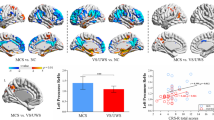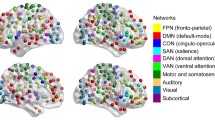Abstract
Understanding the neural mechanisms of disorders of consciousness (DOC) is essential for estimating the conscious level and diagnosing DOC patients. Although previous studies reported brain functional connectivity (FC) and spontaneous neural activity patterns associated with consciousness, the relationship between them remains unclear. In this study, we identified the abnormal brain regions in DOC patients by performing voxel-wise FC strength (FCS) and fractional amplitude of low-frequency fluctuations (fALFF) analyses on resting-state functional magnetic resonance imaging data of 15 DOC patients and 24 healthy controls. Furthermore, we detected spatial intersections between two measures and estimated the correlations between either the FCS or the fALFF and the subscales of the Coma Recovery Scale-Revised (CRS-R). We found that the right superior frontal gyrus, left thalamus and right precuneus in which the DOC patients had a lower local FCS and fALFF than healthy controls, are coincident with regions of the mesocircuit model. In the right precuneus, the local FCS/fALFF was significantly positively correlated with the oromotor and motor scores/motor score of the CRS-R. Our findings may indicate that the co-occurrent pattern of spontaneous neural activity and functional connectivity in the thalamo-frontal circuit and the precuneus are associated with motor function in DOC patients.




Similar content being viewed by others

References
Achard S et al (2012) Hubs of brain functional networks are radically reorganized in comatose patients. Proc Natl Acad Sci USA 109(50):20608–20613
Amico E et al (2017) Map** the functional connectome traits of levels of consciousness. Neuroimage 148:201–211
Ashburner J (2007) A fast diffeomorphic image registration algorithm. Neuroimage 38(1):95–113
Behzadi Y et al (2007) A component based noise correction method (CompCor) for BOLD and perfusion based fMRI. Neuroimage 37(1):90–101
Beucke JC et al (2013) Abnormally high degree connectivity of the orbitofrontal cortex in obsessive-compulsive disorder. JAMA Psychiatry 70(6):619–629
Bisenius S et al (2015) Identifying neural correlates of visual consciousness with ALE meta-analyses. Neuroimage 122:177–187
Blainey P, Krzywinski M, Altman N (2014) Points of significance: replication. Nat Methods 11(9):879–880
Boly M et al (2009) Functional connectivity in the default network during resting state is preserved in a vegetative but not in a brain dead patient. Hum Brain Mapp 30(8):2393–2400
Boly M et al (2011) Preserved feedforward but impaired top-down processes in the vegetative state. Science 332(6031):858–862
Brancucci A et al (2016) A frontal but not parietal neural correlate of auditory consciousness. Brain Struct Funct 221(1):463–472
Buckner RL et al (2009) Cortical hubs revealed by intrinsic functional connectivity: map**, assessment of stability, and relation to Alzheimer’s disease. J Neurosci 29(6):1860–1873
Cavanna AE, Trimble MR (2006) The precuneus: a review of its functional anatomy and behavioural correlates. Brain 129(Pt 3):564–583
Cortese MD et al (2015) Coma recovery scale-r: variability in the disorder of consciousness. BMC Neurol 15:186
Craig AD (2009) How do you feel—now? the anterior insula and human awareness. Nat Rev Neurosci 10(1): 59
Crone JS et al (2014) Altered network properties of the fronto-parietal network and the thalamus in impaired consciousness. Neuroimage Clin 4:240–248
Crone JS et al (2016) Testing proposed neuronal models of effective connectivity within the cortico-basal Ganglia-thalamo-cortical loop during loss of consciousness. Cereb Cortex 27(4):2727–2738
Desmond JE, Glover GH (2002) Eatimating sample size in functional MRI (fMRI) neuroimaging studies: statistical power analyses. J Neurosci Method 118(2002):115–128
Di X et al (2013) The influence of the amplitude of low-frequency fluctuations on resting-state functional connectivity. Front Hum Neurosci 7:118
Fernández-Espejo D et al (2011) Diffusion weighted imaging distinguishes the vegetative state from the minimally conscious state. Neuroimage 54(1):103–112
Friston K (2012) Ten ironic rules for non-statistical reviewers. Neuroimage 61(4):1300–1310
Friston K (2013) Sample size and the fallacies of classical inference. Neuroimage 81:503–504
Giacino JT, Kalmar K, Whyte J (2004) The JFK Coma Recovery Scale-Revised: Measurement characteristics and diagnostic utility. Arch Phys Med Rehabil 85(12):2020–2029
Giacino JT et al (2014) Disorders of consciousness after acquired brain injury: the state of the science. Nat Rev Neurol 10(2):99–114
Gili T et al (2013) The thalamus and brainstem act as key hubs in alterations of human brain network connectivity induced by mild propofol sedation. J Neurosci 33(9):4024–4031
Gooijers J et al (2016) Movement preparation and execution: differential functional activation patterns after traumatic brain injury. Brain 139(Pt 9):2469–2485
Hannawi Y et al (2015) Resting brain activity in disorders of consciousness A systematic review and meta-analysis. Neurology 84(12):1272–1280
He JH et al (2014) Hyperactive external awareness against hypoactive internal awareness in disorders of consciousness using resting-state functional MRI: highlighting the involvement of visuo-motor modulation. NMR Biomed 27(8):880–886
Huang Z et al (2014) The self and its resting state in consciousness: an investigation of the vegetative state. Hum Brain Mapp 35(5):1997–2008
Huang Z et al (2016) Decoupled temporal variability and signal synchronization of spontaneous brain activity in loss of consciousness: An fMRI study in anesthesia. Neuroimage 124:693–703
Itahashi T et al (2015) Alterations of local spontaneous brain activity and connectivity in adults with high-functioning autism spectrum disorder. Mol Autism 6:30
Jenkinson M et al (2002) Improved optimization for the robust and accurate linear registration and motion correction of brain images. Neuroimage 17(2):825–841
Kansal K et al.(2017) Structural cerebellar correlates of cognitive and motor dysfunctions in cerebellar degeneration. Brain 140:707–720
Koch C et al (2016) Neural correlates of consciousness: progress and problems. Nat Rev Neurosci 17(5):307–321
Koivisto M, Revonsuo A (2010) Event-related brain potential correlates of visual awareness. Neurosci Biobehav Rev 34(6):922–934
Kotchoubey B et al (2013) Global functional connectivity reveals highly significant differences between the vegetative and the minimally conscious state. Journal of neurology 260(4):975–983
Lant ND et al (2016) Relationship between the anterior forebrain mesocircuit and the default mode network in the structural bases of disorders of consciousness. Neuroimage Clin 10:27–35
Laureys S, Gosseries O, Tononi G (2015) The neurology of consciousness: cognitive neuroscience and neuropathology. Academic Press, New York
Liu X et al (2014) Scale-free functional connectivity of the brain is maintained in anesthetized healthy participants but not in patients with unresponsive wakefulness syndrome. PLoS ONE 9(3):e92182
Liu W et al (2015) Abnormal degree centrality of functional hubs associated with negative co** in older Chinese adults who lost their only child. Biol Psychol 112:46–55
Lutkenhoff ES et al (2015) Thalamic and extrathalamic mechanisms of consciousness after severe brain injury. Ann Neurol 78(1):68–76
Maki-Marttunen Vn et al (2013) Disruption of transfer entropy and inter-hemispheric brain functional connectivity in patients with disorder of consciousness. Front Neuroinform 14(Suppl 1):P83
Mascali D et al (2015) Intrinsic patterns of coupling between correlation and amplitude of low-frequency fMRI fluctuations are disrupted in degenerative dementia mainly due to functional disconnection. PLoS ONE 10(4):e0120988
Monti MM et al (2015) Thalamo-frontal connectivity mediates top-down cognitive functions in disorders of consciousness. Neurology 84(2):167–173
Norton L et al (2012) Disruptions of functional connectivity in the default mode network of comatose patients. Neurology 78(3):175–181
Owen AM (2008) Disorders of consciousness. Ann N Y Acad Sci 1124:225–38
Qiu M et al (2017) Multi-modal analysis of functional connectivity and cerebral blood flow reveals shared and unique effects of propofol in large-scale brain networks. Neuroimage 148:130–140
Quentin R et al (2014) Fronto-parietal anatomical connections influence the modulation of conscious visual perception by high-beta frontal oscillatory activity. Cereb Cortex 25(8):2095–2101
Riedl V et al (2014) Local activity determines functional connectivity in the resting human brain: a simultaneous FDG-PET/fMRI study. J Neurosci 34:6260–6266
Rosazza C et al (2016) Multimodal study of default-mode network integrity in disorders of consciousness. Ann Neurol 79(5):841–853
Saad ZS et al (2012) Trouble at rest: how correlation patterns and group differences become distorted after global signal regression. Brain Connect 2(1):25–32
Schiff ND (2008) Central thalamic contributions to arousal regulation and neurological disorders of consciousness. Ann N Y Acad Sci 1129:105–118
Schiff ND (2010) Recovery of consciousness after brain injury: a mesocircuit hypothesis. Trends Neurosci 33(1):1–9
Sepulcre J et al (2010) The organization of local and distant functional connectivity in the human brain. PLoS Comput Biol 6(6):e1000808
Tacikowski P, Berger CC, Ehrsson HH (2017) Dissociating the neural basis of conceptual self-awareness from perceptual awareness and unaware self-processing. Cereb Cortex 27(7):3768–3781
Tang L et al (2011) Thalamic resting-state functional networks: disruption in patients with mild traumatic brain injury. Radiology 260(3):831–840
van den Heuvel MP, Sporns O (2011) Rich-club organization of the human connectome. J Neurosci 31(44):15775–15786
Vanhaudenhuyse A et al (2010) Default network connectivity reflects the level of consciousness in non-communicative brain-damaged patients. Brain 133(1):161–171
Wang T et al (2014) Abnormal functional connectivity density in children with anisometropic amblyopia at resting-state. Brain Res 1563:41–51
Weng L et al (2017) Abnormal structural connectivity between the basal ganglia, thalamus, and frontal cortex in patients with disorders of consciousness. Cortex 90:71–87
Wu X et al (2015) Intrinsic Functional Connectivity Patterns Predict Consciousness Level and Recovery Outcome in Acquired Brain Injury. J Neurosci 35(37):12932–12946
Yao S et al (2015) Thalamocortical Sensorimotor Circuit Damage Associated with Disorders of Consciousness for Diffuse Axonal Injury Patients. J Neurol Sci 356(1):168–174
Zang YF et al (2007) Altered baseline brain activity in children with ADHD revealed by resting-state functional MRI. Brain Dev 29(2):83–91
Zhang X-D et al (2015a) Long- and short-range functional connectivity density alteration in non-alcoholic cirrhotic patients one month after liver transplantation: A resting-state fMRI study. Brain Res 1620:177–187
Zhang J et al (2015b) Abnormal functional connectivity density in Parkinson’s disease. Behav Brain Res 280:113–118
Zhou J et al (2011) Specific and nonspecific thalamocortical functional connectivity in normal and vegetative states. Conscious Cogn 20(2):257–268
Zhou Y et al (2014) Characterization of Thalamo-cortical Association Using Amplitude and Connectivity of Functional MRI in Mild Traumatic Brain Injury. J Magn Reson Imaging 39:1558–1568
Zhu J et al (2017) Distance-dependent alterations in local functional connectivity in drug-naive major depressive disorder. Psychiatry Res Neuroimaging 270:80–85
Zou Q et al (2008) An improved approach to detection of amplitude of low-frequency fluctuation (ALFF) for resting-state fMRI: fractional ALFF. J Neurosci Methods 172(1):137–141
Zuo XN et al (2012) Network centrality in the human functional connectome. Cereb Cortex 22(8):1862–1875
Acknowledgements
This work was supported by funding from the National Natural Science Foundation of China (Grant Numbers: 81871338, 81371535, 81428013, 81471654, 81271548, and 81871338), Natural Science Foundation of Guangdong Province, China (2015A030313609). The authors express their appreciation to Drs. Rhoda E. and Edmund F. Perozzi for editing assistance.
Author information
Authors and Affiliations
Contributions
XW analysed the data, wrote the manuscript, and revised the manuscript. XL, HH assisted the data analysis and the manuscript revision. JW, MZ, CN, FD, YH participated in discussion, give some advices for details of the manuscript. QX, RY, QM collected the MRI data and clinical information. YH, YC, XN, YG, assisted to collect the clinical information. RH is the guider of the manuscript, provide the idea of the manuscript and advice of revision.
Corresponding authors
Ethics declarations
Conflict of interest
The authors declare that they have no competing financial interests.
Additional information
Communicated by Yun-Hee Kim.
Electronic supplementary material
Below is the link to the electronic supplementary material.
Rights and permissions
Received:
Accepted:
Published:
Issue Date:
DOI: https://doi.org/10.1007/s10548-018-0693-0



